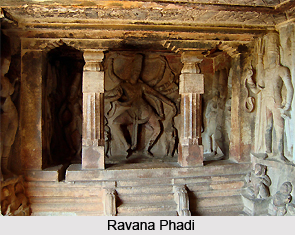 The rock-cut Hindu temple of Ravana Phadi in Aihole, Karnataka, was made during 550 AD. The temple of Ravana Phadi was once decorated with stunning paintings and artworks, but due to lack of proper preservation only remnants of paintings on ceiling still remains. Aihole, which used to the capital during the rule of Chalukya dynasty, consists of 125 temples, of which, most are rock cut Hindu temples. The Ravana Phadi temple is cut in rock, and Lord Shiva is worshipped in the temple.
The rock-cut Hindu temple of Ravana Phadi in Aihole, Karnataka, was made during 550 AD. The temple of Ravana Phadi was once decorated with stunning paintings and artworks, but due to lack of proper preservation only remnants of paintings on ceiling still remains. Aihole, which used to the capital during the rule of Chalukya dynasty, consists of 125 temples, of which, most are rock cut Hindu temples. The Ravana Phadi temple is cut in rock, and Lord Shiva is worshipped in the temple.
Ravana Phadi was created around 550 AD and is amongst the earliest structures in the region. The temple is mainly cut in sandstone, and conserved well. Ravana Phadi contains a vast flat field in the front, which is a unique feature amongst Indian rock-cut temples in India. The opening of the cave is southwest facing, and the cave is located on a platform and a number of stairs need to be covered in order to reach the cave.
A big colossal pillar placed on a quadrangle base is located in front of the entrance hall to the temple. There is also figure of Nandi Bull, ride of Lord Shiva, in a seated posture, near the entrance. On either side of the entrance there are hallways with pillars that enhance the beauty of the architecture. More over the entrance area is ornamented with stone carved columns. There are artworks of well built deities on the sides of the entrance, which probably depict the sentinel of wealth, Kubera.
There is a rectangular hallway inside the cave, known as mandapa, which appears even bigger than the hallways of Badami Cave Temples. The ceiling is decorated with a big carved lotus that is intricately detailed. There are also remains of paintings in the ceiling. The image of Lord Shiva in his Ardhanari incarnation, where he appears in the embodiment of half woman and half man, holding a trident in hand, is also present in the side walls. On the opposite wall, there is another image of Shiva, who is accompanied by Bhagiratha, Parvati, Vishnu and other gods and deities.
There are two chambers on the sides of the Mandapa. In the left side, there are stairs that lead to one of the chambers that contains a stunning artwork of Lord Shiva in Nataraja incarnation. There are also reliefs of Lord Ganesha, Goddess Parvati and Heavenly Mothers, known as Sapta Matrikas. Shiva holds a snake in his hands and one more in his neck, where as Ganesha appears with only 2 arms. The right chamber does not possess any such carvings.
Beyond the mandapa, there are more stairs that lead to a smaller chamber that contain beautiful artworks on the side walls. Goddess Durga is portrayed in the carving. She appears to be slaying Mahishasura, a demon king who appears out of a buffalo, with a trident pierced through his chest, and the demon has crouched on to the ground.
The wall on the opposite side is ornamented with an artwork portraying Lord Vishnu in the incarnation of Varaha. Goddess Bhumi appears on his hand in a seated position. There are pillars that are decorated with carvings of Apsaras. On the ceiling, there are 3 circles that contain carvings of Lord Indra, a lotus, and Lord Vishnu as well as Garuda. There are 3 access points that lead to the most important shrine, where a Lingam of Lord Shiva is located. There is a stunning carving of Bhringi, a saint, as well. He appears to be unhealthy, offering prayer to Lord Shiva.



















